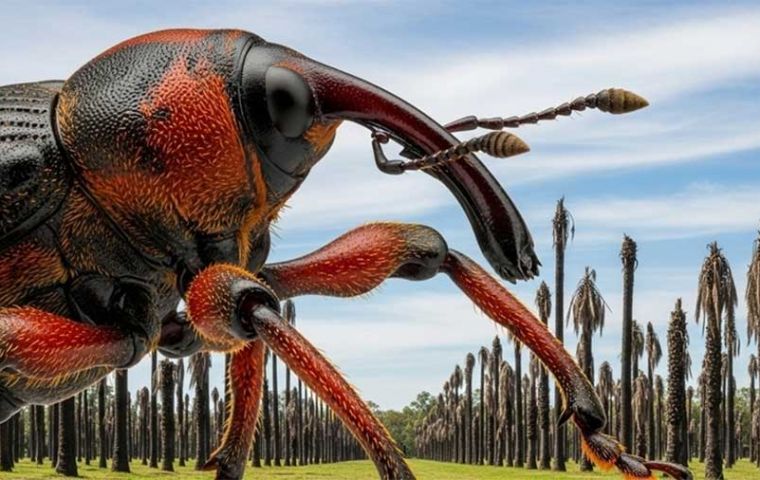MercoPress. South Atlantic News Agency
Uruguay's palm trees under attack by bug foreign to the region
 Rhynchophorus ferrugineus stems from Asia and has not been found anywhere else in South America (Pic ORT)
Rhynchophorus ferrugineus stems from Asia and has not been found anywhere else in South America (Pic ORT) Uruguay's iconic palm trees are facing a severe threat from the red palm weevil (Rhynchophorus ferrugineus), an invasive pest from Southeast Asia. First detected in Uruguay in 2022, the insect has rapidly spread, devouring thousands of trees and alarming authorities.
The red palm weevil quietly destroys palms by laying hundreds of eggs in pruned scars. The hatching larvae tunnel and eat the tree's internal tissue, leading to death within weeks. Symptoms include drooping fronds, holes in the trunk, and a tilting, flattened crown. A major challenge in combating the pest is its “invisible” nature in the early stages, making detection difficult until the damage is often irreversible.
The weevil has been found in 60 countries globally, but nowhere else in South America. In Uruguay, it has spread to eight of the country's 19 regions, including Montevideo, where half of the capital's 19,000 palm trees are estimated to be infected. The pest initially targets decorative Canary palms before moving to date palms. Authorities fear it could spread to native trees in Uruguay's UNESCO biosphere reserve and potentially across the continent. Experts believe that the insect most likely arrived at the port of Montevideo with some cargo and was accidentally introduced.
While acknowledging a late response, Estela Delgado, National Director of Biodiversity at Uruguay's Ministry of Environment, stated a strong commitment to addressing the threat. “We are late in addressing this,” Delgado reckoned. “But we are doing so with great commitment and seriousness.”
In March, a task force was established, and in May, Environment Minister Edgardo Ortuño declared the fight against the weevil a “national priority.”
Montevideo has allocated funding for chemical pesticide sprays and insecticide injections to save approximately 850 trees. The city has also implemented a “vaccination” (endotherapy) program since late 2023, treating over 1,800 palm trees to kill larvae. In its adult stage, Rhynchophorus ferrugineus is between 2 and 5 cm, reddish-brown with black spots and an elongated, beak-shaped face.
Punta del Este authorities have also undertaken efforts such as disposing of infected trees and using pheromone traps.
Despite these measures, the “high” and growing population of the red palm weevil poses a significant and ongoing threat to Uruguay's palm tree population.




Top Comments
Disclaimer & comment rulesCommenting for this story is now closed.
If you have a Facebook account, become a fan and comment on our Facebook Page!